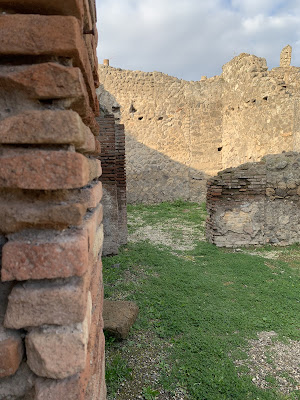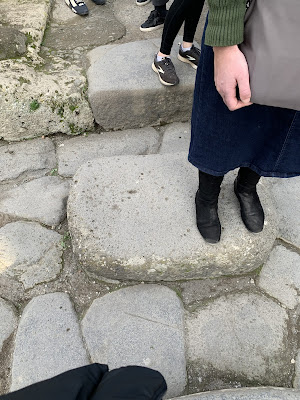I’d grown up reading this history picture book about Mt. Vesuvius, Pompeii, and Herculaneum, and the eruption of 79 A.D. So taking a day trip down there was awesome. Walking the streets of the uncovered ghost town, I felt like I’d been there before. Clearly, those books were well written!
The city was much larger than I’d pictured, going all the way to the mountain range in the background. They’re still uncovering parts of the city, so if you’re interested in archeological digging, you still have a chance.
Being buried under feet of ash and rock, most of the rooftops had collapsed, but so much of the city was still preserved.
Pompeii was originally built in B.C. by the Greeks, and here, you can see the difference between the Greek and Roman pillars. The Roman ones tend to display different kinds of marble. Going through Rome I was surprised at how many kinds of marble there are!
But these Greek pillars, tended to be different shapes. In the foreground, you can see the inside of their pillars, and the background shows what they look like after they’ve plastered them.
Another Greek/Roman difference, is the Greeks liked bronze. These benches in the baths, are the original bronze built by the Greeks, in the other room of the baths, you can see the marble benches. You’ll also notice the mosaic floor. Another one of those things that’s been there for over 2,000 years and hasn’t been wrecked so you’re free to walk all over it. If it’s survived that long, it can survive you.
Pompeii’s road system was impressive, they even had road blocks at the ends of the pedestrian streets so chariots and carts couldn’t enter.
This mosaic of a dog on a chain is the equivalent of our “Beware of dog” signs.
This bakery had four different kinds of grain grinder stones. I’m not sure if they were for different kinds of grains, or for different varieties of coarseness, but they were pretty neat.
I thought this picture was unique, because you have this ancient city in the background, green trees, and a Christmas train. It’s hard to think Christmas when it’s in the 60s.
This bakery had an awesome oven system. They found bread still in some of the ovens when they uncovered the city. Those round holes were built into stone, and they’d put pots in there to keep liquids cool.
They had raised stepping stones in many places across the pedestrian streets so that when heavy rains came, and the streets were flooding, you could cross the street without getting your toga wet.
The rocks used for the roads was a volcanic rock. You can still see marks in the rock from an earlier eruption. It’s erupted about 3 dozen times since then, with its most recent eruption in 1944. You can find videos on YouTube of the eruption caught on camera by American soldiers who were there for WW2.
This softer rock has deep indents from the metal rimmed wheels.
There were a lot of temple things preserved, including a sculpture of Zeus. Honestly, studying the city was like studying Sodom and Gomorrah. Right down to the raining of fire and brimstone.
Mt. Vesuvius had clouds hanging over the top all day, and almost looked like it was smoking.
This was the gladiator trading ground right by the arena.
The white seats in the arena are marble, and they found documentation with the price of different seats, with the marble one’s being the most expensive.
This is one of the original Greek roads with the volcanic rocks.
The shops in Pompeii all had sliding doors that they could lock up at night. You can still see all the tracks.
This castle was actually in Naples, and was a soldier’s fortification but I don’t remember what year it was built… I think 15th century?































No comments:
Post a Comment
Thank You for your comments!